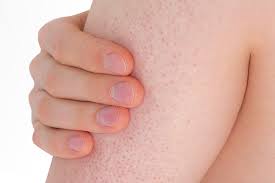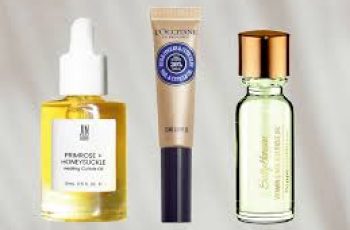
Bumpy, Rough Skin: Causes and Treatment Options
Bumpy, rough skin is a common complaint among people with many different skin types and can be caused by a variety of skin conditions, including keratosis pilaris, folliculitis, and dry skin due to an impaired skin barrier.
Find out how to tell if you might be dealing with one of these common dry skin conditions and what the best treatment options are to get rid of and prevent rough bumpy skin in the future.
Different kinds of rough bumps on the skin
What are rough bumps on skin?
Many things can cause rough bumpy skin. Here is the differential diagnosis of sandpaper like or small rough bumps on skin:
Acne
Actinic Keratosis
Asteatotic Eczema
Dermatitis Herpetiformis
Folliculitis
Goose Bumps (also known as Piloerection or Cutis Anserina)
Granuloma Annulare
Ingrown Hairs (Pseudofolliculitis)
Keratosis Pilaris
Lichen Planus
Milia
Molluscum Contagiosum
Perioral Dermatitis
Seborrheic Keratosis
Of these, the one that feels most like sandpaper is keratosis pilaris.
Keratosis Pilaris
Keratosis pilaris, often referred to as KP, is a common skin condition that causes dry, sandpaper-like bumps on the skin, usually on the arms and outer thighs. These bumps, caused by an increase in keratin production, are typically red or flesh-colored and do not itch or hurt. While KP bumps are harmless, they can be unsightly if left untreated, so many men and women with these rough bumps choose to speak with a dermatologist about the best treatment options for KP.
Exfoliation and moisturization are the two most important steps when treating KP bumps. Exfoliants help to remove the buildups of keratin on the skin that create these bumps, while moisturization helps to prevent continued keratin buildup in the future.
The type of exfoliant to choose for your skin care routine depends upon your skin type. Sensitive skin, for example, tolerate chemical exfoliants such as hydroxy acids better than physical exfoliants such as scrubs.
Here are some dermatologist- recommended body scrubs:
Revision Skincare Finishing Touch
$58.00
Out of Stock
Nuxe Reve de Miel Deliciously Nourishing Body Scrub
$38.00
Out of Stock
Jan Marini Bioglycolic Resurfacing Body Scrub
$80.00
Add to Cart
What are goosebumps?
Goosebumps
Goose bumps, also known as “piloerection,” are a temporary change in the skin that occurs in response to various stimuli, most commonly cold or emotional stress. This phenomenon is a reflex action orchestrated by the sympathetic nervous system, which is the part of the nervous system that prepares your body to respond to stress or cold. Here’s the step-by-step process:
Stimulus and Nervous System Activation: When the body is exposed to a cold environment or experiences a strong emotion (like fear or excitement), the sympathetic nervous system is activated.
Release of Neurotransmitter: The activation of the sympathetic nervous system leads to the release of a neurotransmitter called norepinephrine (also known as noradrenaline).
Muscle Contraction: Norepinephrine acts on tiny muscles at the base of hair follicles called “arrector pili” muscles. When these muscles contract, they pull the hair follicles upward, creating a raised spot on the skin.
Appearance of Goose Bumps: This pulling action of the contracted arrector pili muscles causes the surrounding skin to form small, raised points, which we refer to as “goose bumps.”
Purpose in Animals: In many animals, this response increases the amount of air trapped in the fur, which adds insulation and increases warmth, or makes the animal appear larger to frighten potential predators. This is akin to a cat puffing up its fur when it is frightened.
Human Response: In humans, this reflex doesn’t have the same practical applications since we don’t have a thick coat of fur. It’s considered to be a vestigial response, meaning it’s a leftover trait from our evolutionary past.
Resolution: Once the stimulus (cold or emotional stress) is removed or lessened, the nervous system signaling decreases, the arrector pili muscles relax, and the skin smooths down again, causing the goose bumps to disappear.
It’s worth noting that “goose bumps” get their name from the way the skin looks during this reaction—similar to the skin of a plucked goose, where the feather shafts were attached.
Patches of goosebumps on skin that do not go away and goosebumps on the face are most likely keratosis pilaris.
Why do we get goosebumps?
Goosebumps are a physiological phenomenon that occur as part of the body’s fight-or-flight response, which is triggered by various forms of stress including cold temperatures, fear, or emotional arousal. When we are cold, the contraction of small muscles called arrector pili at the base of hair follicles (caused by the release of the neurotransmitter norepinephrine) pulls the hairs upright. In furry animals, this action creates an insulating layer of air trapped beneath the erect hairs, helping the animal to retain heat. In humans, this response is largely vestigial, as we have significantly less body hair, but it follows the same pattern. When we are scared or emotionally stimulated, the same fight-or-flight response is activated. In this context, the piloerection reflex is thought to be a defensive mechanism that, in animals, makes them appear larger or more threatening to predators.
For humans, goosebumps during emotional moments, such as while listening to a moving piece of music, are a lingering echo of this ancient reflex, showcasing the profound link between our emotions and physiological responses, even when the response itself no longer serves a clear practical function.
What is folliculitis?
Folliculitis
Red, pus-filled bumps that appear in areas where you shave, such as under your arms, on your legs, or face, are likely caused by a condition called folliculitis. Folliculitis occurs when a hair follicle becomes inflamed, usually caused by a bacterial or fungal infection.
In addition to shaving, wearing tight-fitting clothing when working out, not changing clothes immediately after sweating, and soaking in improperly-maintained hot tubs can cause folliculitis. A specific type of folliculitis, called pityrosporum folliculitis, is likely the cause of a common skin rash seen in many people who wear Lululemon or other tight-fitting pants to the gym. This type of folliculitis often resembles acne but is distinct in that it causes itching, whereas acne typically does not.
The best treatments for folliculitis depend on the type and cause of folliculitis you have, as well as how mild or severe it is. Mild cases of folliculitis may clear up on their own, and warm compresses can help to soothe skin in the meantime. For more severe or recurrent cases, your dermatologist might prescribe topical or oral medications to clear the infection.
To prevent folliculitis in the future:
Use a moisturizing shaving cream each time you shave.
Shave in the direction of hair growth, not against it.
Shower or change clothes immediately after working out.
Avoid wearing tight clothing such as leggings, especially when working out, if you begin to develop a bumpy rash.
Use a skin care routine for your skin type
We can help you find the best skin care routine to treat your unique skin issues.
[ctaquiz”>
Treatments for rough, dry skin
Dry Rough skin
Rough, itchy, or ashy skin can also be caused by dehydration. Skin becomes dry and dehydrated when its protective barrier is impaired and unable to function properly. An impaired skin barrier will have trouble retaining moisture and keeping allergens and irritants out.
While some people are genetically predisposed to have dry, dehydrated skin, lifestyle factors such as spending lots of time in the sun or exposing the skin to cold wind in the winter can also contribute to a damaged skin barrier.
Dry skin in darker skin tones can sometimes appear to be gray or ashy and often feels rough or bumpy.
Adding a barrier repair moisturizer or oils to your daily skincare regimen will help your skin to retain moisture, diminishing the appearance of ashy skin.
Very dry or ashy skin can benefit from twice-daily applications of a good-quality barrier repair moisturizer. As your skin begins to repair itself, you should notice dryness, itching, and flaking diminish, revealing a smoother and brighter complexion. Darker skin types rave about Zerafite Brightening Barrier Cream to treat rough bumps on dark skin and brighten the skin.
Moisturizers for rough, bumpy skin
Moisturizers to treat rough bumpy skin
To restore proper skin barrier function and healthy hydration to your skin, use a barrier repair moisturizer that has a maltese cross pattern under the microscope which means it can mimic your skin’s natural lipid structure and repair barrier damage.
You can learn more about these in my interview with a skin barrier expert on YouTube.
The best barrier repair creams to treat bumpy rough skin should be chosen based on what other issues your skin has.
If it is red and rough and bumpy, use Zerafite Soothing and Calming Moisturizer.
I it is rough and bumpy and wrinkled use Zerafite Wrinkle Defense Barrier Cream Moisturizer.
If it is rough and bumpy with dark spots use Zerafite Brightening Barrier Cream
Other moisturizers to treat bumpy sandpaper skin on the face are:
Zerafite Barrier Repair Moisturizer
$50.00
Add to Cart
Zerafite Soothing and Calming Moisturizer
$9.99
Add to Cart
Zerafite Skin Brightening Barrier Cream
$10.99
Add to Cart
Derma Made Ceramide Barrier Cream
$35.00
Add to Cart
La Roche-Posay Toleriane Dermallergo Night Moisturizer
$31.97
Add to Cart
Obagi Hydrate Luxe
$80.00
Add to Cart
Medature PSL Repair Moisturizer
$48.00
Add to Cart
Revision Skincare D.E.J. Face Cream
$72.00
Add to Cart
SkinCeuticals Triple Lipid Restore 2:4:2
$155.00
Add to Cart
Alastin Ultra Nourishing Moisturizer
$88.00
Add to Cart
Zerafite Barrier Repair Moisturizer
$50.00
Add to Cart
Zerafite Soothing and Calming Moisturizer
$9.99
Add to Cart
Zerafite Skin Brightening Barrier Cream
$10.99
Add to Cart
Derma Made Ceramide Barrier Cream
$35.00
Add to Cart
La Roche-Posay Toleriane Dermallergo Night Moisturizer
$31.97
Add to Cart
Obagi Hydrate Luxe
$80.00
Add to Cart
Medature PSL Repair Moisturizer
$48.00
Add to Cart
Revision Skincare D.E.J. Face Cream
$72.00
Add to Cart
SkinCeuticals Triple Lipid Restore 2:4:2
$155.00
Add to Cart
Alastin Ultra Nourishing Moisturizer
$88.00
Add to Cart
Zerafite Barrier Repair Moisturizer
$50.00
Add to Cart
Zerafite Soothing and Calming Moisturizer
$9.99
Add to Cart
Zerafite Skin Brightening Barrier Cream
$10.99
Add to Cart
Derma Made Ceramide Barrier Cream
$35.00
Add to Cart
La Roche-Posay Toleriane Dermallergo Night Moisturizer
$31.97
Add to Cart
Obagi Hydrate Luxe
$80.00
Add to Cart
Medature PSL Repair Moisturizer
$48.00
Add to Cart
Revision Skincare D.E.J. Face Cream
$72.00
Add to Cart
SkinCeuticals Triple Lipid Restore 2:4:2
$155.00
Add to Cart
Alastin Ultra Nourishing Moisturizer
$88.00
Add to Cart
Body creams to treat sandpaper like rough bumpy skin on the arms. legs, or body include:
La Roche-Posay Lipikar AP+M Triple Repair Moisturizing Cream
$9.99
Add to Cart
Bioderma Atoderm Intensive Balm
$20.99
Add to Cart
Bioderma Atoderm Creme Ultra-Nourishing Moisturizing Cream
$17.99
Add to Cart
Zerafite Ultra Rich Body Cream Barrier Repair Moisturizer
$40.00
Add to Cart
La Roche-Posay Lipikar Eczema Soothing Relief Cream
$15.99
Add to Cart
Derma Made Ceramide Barrier Cream
$35.00
Add to Cart
La Roche-Posay Lipikar AP+M Triple Repair Moisturizing Cream
$9.99
Add to Cart
Bioderma Atoderm Intensive Balm
$20.99
Add to Cart
Bioderma Atoderm Creme Ultra-Nourishing Moisturizing Cream
$17.99
Add to Cart
Zerafite Ultra Rich Body Cream Barrier Repair Moisturizer
$40.00
Add to Cart
La Roche-Posay Lipikar Eczema Soothing Relief Cream
$15.99
Add to Cart
Derma Made Ceramide Barrier Cream
$35.00
Add to Cart
La Roche-Posay Lipikar AP+M Triple Repair Moisturizing Cream
$9.99
Add to Cart
Bioderma Atoderm Intensive Balm
$20.99
Add to Cart
Bioderma Atoderm Creme Ultra-Nourishing Moisturizing Cream
$17.99
Add to Cart
Zerafite Ultra Rich Body Cream Barrier Repair Moisturizer
$40.00
Add to Cart
La Roche-Posay Lipikar Eczema Soothing Relief Cream
$15.99
Add to Cart
Derma Made Ceramide Barrier Cream
$35.00
Add to Cart
Body oils to smooth rough bumpy skin:
VMV HYPOALLERGENICS Oil’s Well Nurturing Do-It-Oil
$40.00
Out of Stock
Nuxe Prodigieux Huile de Douche Shower Oil
$18.00
Out of Stock
In Summary
There are many causes of dry, bumpy, or rough skin. To effectively treat these common skin concerns, you must first know your Baumann Skin Type so that you will know which moisturizing ingredients are best to treat the skin bumps.
Remember that rough, bumpy skin can be caused or worsened by environmental factors such as sweating in tight clothing, using the wrong shaving techniques, and dehydration caused by sun exposure. Because of this, it is important to combine the proper treatment products with healthy lifestyle habits to maintain soft, smooth, healthy skin.


